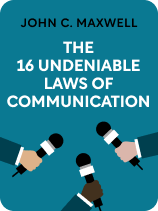

This article is an excerpt from the Shortform book guide to "The 16 Undeniable Laws of Communication" by John C. Maxwell. Shortform has the world's best summaries and analyses of books you should be reading.
Like this article? Sign up for a free trial here.
How can you read the room even before you speak? How should you respond to certain reactions you get during your presentation?
Even the most prepared speaker must be ready to be flexible during their speech. A skilled public speaker knows how to read the room and go with that flow in order to maintain the connection between them and their audience.
Read more for John C. Maxwell’s advice on how to read the room and adjust your speech as needed.
Read the Room & Adapt
Preparation is essential to communicating your message to an audience. However, this doesn’t mean sticking rigidly to a script. Situations change, and unexpected obstacles arise. To communicate well, you must measure how the audience is responding to you and adapt on the spot to engage audiences that are indifferent or distracted. In other words, you must know how to read the room and keep your audience with you.
(Shortform note: Experts suggest you look for three things when measuring your audience’s response to you: attentiveness, engagement, and sentiment. First, check how attentive your audience is by looking for signs of boredom or distraction (yawning, multitasking, moving around). Next, look for signs of engagement (asking questions or taking notes). Lastly, get a sense of how your audience is feeling—whether they’re enjoying the presentation (smiling or sitting relaxed) or unhappy (rolling their eyes or sighing). If these signs indicate that you’re losing your audience, consider adapting by asking an open-ended question to get them involved or offering them a quick break.)
Before you’re scheduled to speak, Maxwell recommends you get a better sense of how your audience might respond to you by inspecting the location ahead of time and considering the type of event you’re speaking at. Look at factors such as lighting, sound, the location of projector screens, and the overall setup and size of the room. This allows you to rearrange or correct anything or, at the very least, get clues as to whether the audience will be comfortable and engaged or reluctant and unresponsive.
(Shortform note: Some experts offer suggestions on how precisely to assess and change your speaking environment before your presentation. If you have the choice, arrange the room so that audience members are seated as closely together as possible while still being comfortable. This helps you form a closer connection with your audience. Additionally, try to give your presentation at a distance from distracting areas of the room, such as doors or windows, as outside movement may distract your audience.)
If, during your talk, you read the room and notice that the audience is unengaged, here are a few suggestions on how to recapture their attention on the fly:
1. Interact with the audience. Get the audience to interact by asking questions that require them to shout out answers or raise their hands. You can also encourage them to say or share something with a neighbor.
(Shortform note: If you have an audience that seems too shy to raise hands or hesitant to interact, you can use technology to allow people to engage more anonymously. Consider using a live polling tool that allows audience members to respond to questions on their phones or laptops. You can even create a hashtag for your presentation on Twitter and broadcast your audience member’s tweets at strategic moments in your presentation.)
2. Do something unexpected. If you notice your audience is losing interest, Maxwell suggests you be spontaneous and do something that the audience didn’t anticipate to grab their attention. For example, you could bring your pet or young child on stage if they inspired one of your ideas.
(Shortform note: According to Carmine Gallo in Talk Like TED, when you do something your audience doesn’t expect, you increase the magnitude of their emotional response. When people’s emotions are heightened, they pay attention to things more and form stronger memories of the experience. This is because their brains release a chemical called dopamine which creates pleasurable feelings and also improves the brain’s ability to process information.)
3. Use pauses strategically. Pauses can help emphasize your point and give audience members time to process your message. You can also pause to recapture people’s attention. When you stop talking, people naturally return their focus to you as they wonder what caused the sudden silence.
(Shortform note: While Maxwell suggests you incorporate more pauses into your presentation, some experts suggest there are times when pauses work against you: Pausing for too long after you’ve been asked a question can make you seem insincere. They recommend that, apart from questions that are clearly difficult, you should try to fill the silence following a question immediately. If you’re not sure of the answer, buy time by repeating the question, asking for clarification, or even resorting to some filler phrases. However, don’t let this fact scare you away from answering questions from your audience. Trust in your preparation and compose some backup phrases to say beforehand.)

———End of Preview———
Like what you just read? Read the rest of the world's best book summary and analysis of John C. Maxwell's "The 16 Undeniable Laws of Communication" at Shortform.
Here's what you'll find in our full The 16 Undeniable Laws of Communication summary:
- The secrets to becoming a confident and effective communicator
- How anyone can master public speaking, no matter how nervous they get
- How to write a clear and engaging speech






